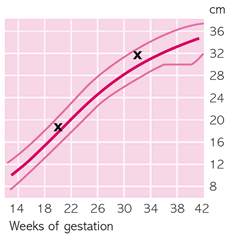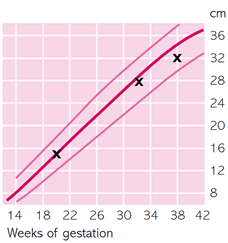Fetal Growth Chart

If your doctor has any concerns about your baby's growth later in pregnancy, he or she may arrange for scans to be done over a period of time so that your baby's growth can be plotted on a chart and monitored. Individual measurements will be taken of the head, abdomen, and limbs. Measurements of the head and abdomen are most important since an unequal growth pattern in these areas may indicate a particular problem.
The three lines on the graphs here represent different growth rates. The red line in the center, referred to as the 50th percentile, shows an average pattern of growth. The thinner lines above and below, the 90th and the 10th percentiles, show the top and bottom ranges of normal growth. Since the head and abdominal circumferences are measured over time and plotted on a graph, a pattern of growth becomes clear. Here, the head is growing normally, but growth has slowed in the abdomen, possibly due to a placental problem that in itself may be caused by a condition in the mother. For example, conditions such as high blood pressure (see Blood pressure checks) or diabetes can affect placental blood flow. If the blood flow to the baby is restricted, this can result in the oxygen and nutrients carried in the blood being diverted to the baby's most vital organs, the brain and heart, rather than to the abdominal organs, which results in unequal growth patterns in the head and abdomen.
A Doppler scan is a special scan that analyzes blood flow through the placenta. If the placenta is functioning well, the blood flows easily. If there is a problem in the placenta, it is resistant to the blood flow and the baby's heart has to work harder to pump blood. In extreme cases, there are periods between your baby's heartbeats of no blood flow or reversed blood flow through the umbilical cord. In this case, an early delivery may be suggested unless you're very premature.

Head circumference


